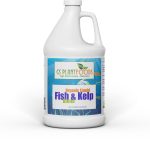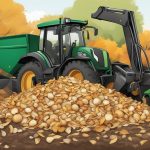A compost pile and a compost bin have similarities but differ in terms of size and accessibility for turning the compost. Both options foster the natural decomposition of organic materials into nutrient-rich compost that can be used to enrich garden soil.
Compost piles are typically larger and require more space, allowing for easy turning and aeration of the materials. On the other hand, compost bins are smaller and contained, offering a neater appearance and protection from pests.
While compost piles are suitable for larger properties and people who have more yard waste, compost bins are more convenient and manageable for smaller spaces or individuals seeking a tidier composting solution.
Ultimately, the choice between a compost pile or bin depends on personal preference and the specific requirements of the situation.
Why It Is Important To Composting In Organic Gardening?
Composting is an essential practice in organic gardening that helps improve soil health, nurture plants, and protect the environment. With various composting methods available, such as compost piles and bins, it can be challenging to determine which is best for your needs. The difference between compost piles and bins, shedding light on their advantages and helping you make an informed decision.
Importance Of Organic Matter In Soil Health
Before diving into the specifics of composting methods, it is crucial to understand the significance of organic matter in soil health.
Organic matter, which consists of decomposed plant and animal materials, acts as a natural fertilizer for your garden.
It enhances the soil structure, improves moisture retention, and encourages beneficial microbial activity.
By incorporating organic matter into your soil, you create a nurturing environment for plant roots, promoting healthy growth and ensuring better nutrient absorption.
Moreover, organic matter plays a vital role in preventing soil erosion, as it binds soil particles together, protecting them from the impact of heavy rainfall or strong winds.

Benefits Of Composting For Plants And The Environment
Composting plays a crucial role in supporting plant growth and protecting the environment. Let’s delve deeper into the benefits it offers:
- Nutrient-rich soil: Composting transforms organic waste into nutrient-rich humus that replenishes the soil with essential nutrients, including nitrogen, phosphorus, and potassium. These nutrients are vital for providing plants with the sustenance they need for healthy growth and development.
- Improved soil structure: Compost improves soil structure by enhancing its ability to retain moisture, making it easier for plant roots to access water. Additionally, it improves the soil’s aeration, allowing oxygen to reach the roots more effectively.
- Enhanced microbial activity: Compost fosters the growth of beneficial microorganisms in the soil, including bacteria, fungi, and earthworms. These microorganisms break down organic matter into its nutrient components, making them readily available for plant roots.
- Reduced environmental impact: Composting helps reduce the amount of organic waste that ends up in landfills, where it contributes to the production of harmful greenhouse gases. By composting, you not only recycle valuable nutrients but also minimize the environmental footprint associated with waste disposal.
It is worth emphasizing that composting is not limited to large-scale agriculture or professional gardeners. Even small-scale home gardeners or individuals with limited outdoor space can benefit from composting using methods like compost piles or bins.
Key Role Of Compost In Providing Essential Nutrients
Compost is often referred to as “black gold” due to its rich nutrient content. It provides a balanced blend of essential nutrients such as nitrogen, phosphorus, and potassium, along with trace minerals that are vital for plant health.
These nutrients are slowly released into the soil, ensuring a steady supply to nourish your plants throughout their growth cycle.
The organic matter present in compost also helps improve the soil’s water-holding capacity, preventing water runoff and reducing the need for frequent irrigation.
Additionally, compost acts as a natural buffer, balancing the pH level of the soil and creating an optimal environment for plant root development.
By adding compost to your organic garden, you can reduce the reliance on synthetic fertilizers, which often come with negative environmental consequences. Compost provides a sustainable and eco-friendly alternative, supporting long-term soil health and promoting the growth of vibrant, resilient plants.
Compost Pile: The Natural Approach To Organic Gardening
A compost pile is a heap of organic materials that, with the help of microorganisms, breaks down into nutrient-rich compost. Unlike a compost bin, a compost pile allows for more airflow and facilitates natural decomposition. This method is perfect for gardeners who have ample space and prefer a hands-off approach to composting. To properly maintain a compost pile, consider the following:
- Size: Your compost pile should ideally be at least three feet wide and three feet tall. Smaller piles may not generate enough heat, while larger piles may create anaerobic conditions, hindering the composting process.
- Airflow: Ensuring adequate airflow is essential for a compost pile. You can achieve this by occasionally turning or aerating the pile to provide oxygen. This promotes the growth of aerobic bacteria that break down the materials effectively.
- Layering: Aim to create a diverse mix of materials in your compost pile. Layer green nitrogen-rich materials, such as fruit and vegetable scraps or grass clippings, with brown carbon-rich materials, such as dried leaves or straw. Alternate these layers to balance the carbon-to-nitrogen ratio for optimal composting.
- Moisture: Keep your compost pile moist, similar to a wrung-out sponge. Regularly check the moisture level by squeezing a handful of the compost; it should feel damp but not soggy. If it’s too dry, add water, and if it’s overly wet, add dry brown materials to absorb the excess moisture.
How To Choose The Right Location For Your Compost Pile?
When setting up a compost pile, the location plays a crucial role in its success. Consider the following factors to choose the best spot:
Sunlight: Place your compost pile in an area that receives partial to full sunlight. Sunlight aids in maintaining the optimal temperature for composting, speeding up the decomposition process.
Drainage: Ensure that the chosen location has adequate drainage. Avoid low-lying areas or spots prone to waterlogging, as excess moisture can impede the composting process.
Accessibility: Select a location that is easily accessible for adding materials, turning the pile, and harvesting compost. It should be convenient to transport materials to and from the compost pile, saving you time and effort.
Odor: Keep in mind that composting produces a distinct earthy smell. Choose a location away from living areas or open windows to minimize any potential odor inconvenience.

What Materials To Include And Avoid In Your Compost Pile?
When composting, it’s important to include the right materials to ensure successful decomposition and avoid introducing unwanted substances. Here’s a list of materials that you should include and avoid:
| Included Materials | Avoided Materials |
|---|---|
|
|
Benefits Of Using A Compost Bin In Organic Gardening
Space-saving and neat composting solution
A compost bin is a space-saving solution, especially for those with limited garden space. Unlike compost piles that occupy a significant portion of your garden, a compost bin can be conveniently placed in a smaller area.
Its compact design enables homeowners with even the smallest of yards or balconies to embrace composting without sacrificing valuable space.
Additionally, the structure of a compost bin ensures that the organic waste is contained, keeping your garden looking neat and organized. The closed system of a compost bin prevents stray leaves, vegetable scraps, or other compostable materials from spreading around your garden, creating an unsightly mess.
Controlling odors and pests with a compost bin
One of the primary concerns when composting is the potential for odors and pests. Compost piles, especially when not appropriately managed, can emit unpleasant odors that may not be well received by neighbors or passersby. However, a compost bin helps address this issue by providing a controlled composting environment.
The enclosed design of a compost bin effectively contains the composting process, preventing odor diffusion. As a result, you can enjoy the benefits of composting without any unpleasant smells lingering in your garden or nearby areas. Moreover, a compost bin also aids in keeping pests at bay.
The secure structure deters rodents, raccoons, and other critters from rummaging through your compost heap, preventing them from causing any disturbance or potential damage to your organic garden.
How Do You Select The Right Compost Bin For Your Garden?
Choosing the right compost bin for your garden is an important decision that can greatly impact the success of your composting efforts. With a wide range of options available, it can be a bit overwhelming to determine which one best suits your needs.
Different Types Of Compost Bins Available
When it comes to compost bins, there is certainly no shortage of choices. Here are some common types of compost bins:
Traditional compost pile: This is the simplest and most cost-effective option, requiring minimal setup. It involves creating a pile of organic waste directly on the ground or in a designated composting area. It allows for a larger volume of compost and provides a natural environment for decomposers.
Compost bin: A compost bin is a container specifically designed for composting. It can be made of various materials such as plastic, wood, or metal. This option offers better containment of the compost and can help regulate temperature and moisture levels.
Tumbling compost bin: A tumbling compost bin is a type of compost bin that allows for easy turning or rotating of the compost. It speeds up the decomposition process by providing regular aeration and mixing.
Worm composting bin: Also known as vermicomposting, this type of bin utilizes worms to break down organic waste. It is compact, odorless, and ideal for those with limited space, such as apartment dwellers or urban gardeners.
Factors To Consider When Choosing A Compost Bin
When selecting a compost bin, there are several factors you should take into consideration:
- Space: Assess the available space in your garden or backyard. Some compost bins require more room than others, so make sure you choose one that fits comfortably in your designated composting area.
- Capacity: Consider the amount of organic waste you generate and the volume of compost you need. If you have a large garden or produce a significant amount of waste, you may require a larger compost bin or a traditional compost pile.
- Materials: Different compost bins are made from various materials, each with its advantages and disadvantages. Plastic bins are lightweight, durable, and easy to clean, while wooden bins blend well with natural surroundings. Metal bins offer sturdiness but can be prone to rust.
- Functionality: Think about how you prefer to manage your compost. Some bins allow for easy turning or tumbling, while others require manual mixing. Consider your personal preferences and the amount of effort you are willing to put into maintaining your compost.
Diy Vs. Commercially Available Compost Bins
One decision you’ll need to make is whether to opt for a DIY compost bin or purchase a commercially available one. Here’s a comparison of the two options:
| DIY compost bins | Commercially available compost bins |
|---|---|
| Cost-effective | Wide variety to choose from |
| Allows customization based on available materials | Designed for optimal composting conditions |
| May require more effort in terms of assembly and maintenance | Generally easier to set up and use |
| Can be less aesthetically pleasing | Often available in aesthetically pleasing designs |
How To Create a Perfect Compost Pile?
If you’re passionate about sustainability and gardening, creating your compost pile is a fantastic way to reduce waste and nourish your plants.
To ensure that your compost pile becomes a thriving ecosystem, it’s important to follow specific techniques and maintain the ideal balance of materials.
Layering Technique For Efficient Decomposition
A well-layered compost pile promotes efficient decomposition, allowing the organic materials to break down effectively. The layering technique involves alternating layers of carbon-rich and nitrogen-rich materials.
Carbon-rich materials, often referred to as browns, include items like dried leaves, straw, and twigs. On the other hand, nitrogen-rich materials, also known as greens, consist of fresh grass clippings, kitchen scraps, and plant trimmings.
The combination of these two materials creates the perfect balance for decomposition.
Balancing Carbon-rich And Nitrogen-rich Materials
To achieve the ideal balance of carbon-rich and nitrogen-rich materials, it’s important to maintain a ratio of roughly 3 parts browns to 1 part greens. This ensures that the pile has enough carbon to provide energy for the microorganisms responsible for decomposition.
Too much nitrogen-rich material can result in a smelly, slimy pile, while an excess of carbon-rich material may slow down the decomposition process.
A balanced mix of greens and browns will optimize the decomposition rate and create nutrient-rich compost.

Monitoring And Maintaining Moisture Levels In The Pile
Monitoring and maintaining the moisture levels in your compost pile is crucial for successful decomposition. The pile should be kept moist, similar to a damp sponge. If the pile becomes too dry, decomposition will slow down, and the process will be less effective.
Conversely, if the pile becomes too wet, it may become anaerobic, leading to unpleasant odors and nutrient loss. Regularly checking the moisture content and adding water when needed will ensure that the microorganisms thrive and efficiently break down the organic materials.
What Are Common Issues With Compost Bins?
While compost bins are a valuable tool for organic waste management, they can encounter a few common problems. Here are some troubleshooting tips to ensure that your compost bin remains healthy and productive:
- Odor: If your compost bin starts emitting foul odors, it is likely due to inadequate aeration or a high concentration of nitrogen-rich materials. To address this, ensure that your compost bin has proper airflow and adjust the carbon-to-nitrogen ratio by adding more browns.
- Pests: Unwanted pests can infiltrate compost bins, attracted to the organic matter. To discourage pests, avoid adding meat, dairy, or oily foods to your compost. Additionally, make sure the bin is securely sealed, and consider using a mesh or wire cover to keep pests out.
- Moisture: Compost needs the right amount of moisture to decompose effectively. If your compost pile is too dry, add water gradually until it reaches a moist but not soggy consistency. If it is too wet, add dry materials like shredded newspaper or dry leaves to absorb excess moisture.
- Slow decomposition: If your compost is taking longer than expected to decompose, check the carbon-to-nitrogen ratio and adjust it if necessary. Ensure that the compost is properly aerated and turned regularly. If needed, break down larger materials into smaller pieces to speed up decomposition.
Can I Incorporate Compost In Potting Soil And Seed Starting?
When it comes to gardening, incorporating compost into potting soil and seed starting can greatly benefit the growth and health of your plants. Compost, a nutrient-rich organic matter, is the result of decomposed organic materials such as kitchen scraps, leaves, and yard waste. Its ability to improve soil structure and provide essential nutrients makes it an excellent addition to potting soil and a valuable resource for starting seeds.
Enhancing Potting Soil Mixture With Compost
Enhancing your potting soil mixture with compost is a fantastic way to boost its fertility and overall quality. By adding compost, you improve the soil’s ability to retain moisture, ensure proper drainage, and enhance nutrient availability to your plants.
When creating a potting soil mixture, aim for a ratio of one part compost to two parts potting soil. This ratio provides a healthy balance of organic matter, minerals, and nutrients necessary for the optimal growth of your potted plants. By incorporating compost into your potting soil, you give your plants a head start, setting them up for success.
Some benefits of incorporating compost into your potting soil include:
- Improved soil structure and texture
- Enhanced nutrient retention and availability
- Increased moisture-holding capacity
- Reduced soil erosion
- Support for beneficial soil organisms
Seed Starting Tips Using Compost
When it comes to starting seeds, compost can play a vital role in ensuring their successful germination and healthy growth. Here are some tips for using compost in your seed-starting process:
- Select a seed starting mix or create your own by combining equal parts compost and coconut coir or vermiculite.
- Fill seed trays or pots with the compost-based seed starting mix, ensuring they are well-draining and sterile.
- Sow seeds according to their specific requirements, following the instructions on the seed packet.
- Ensure proper moisture levels by misting the soil surface or using a bottom-watering technique.
- Place the seed trays or pots in a warm and well-lit area, providing adequate sunlight or using artificial grow lights.
- Monitor the moisture levels regularly and make sure the seeds receive sufficient water without becoming waterlogged.
- Transplant seedlings into larger pots or the garden once they have developed strong roots and several sets of leaves.
Compost Tea And Its Benefits For Seedlings
Compost tea, a water-based extract made from compost, is a powerful liquid fertilizer that can provide numerous benefits to your seedlings. It contains essential nutrients, beneficial microorganisms, and plant growth hormones that support healthy plant development.
To make compost tea, simply steep compost in water for a designated period and strain the liquid. This nutrient-rich tea can be applied to seedlings as a foliar spray or used to water them at the roots. The benefits of compost tea for seedlings include:
- Improved nutrient absorption
- Enhanced root development
- Increased disease resistance
- Stimulated plant growth and vigor
Can I Make Healthier Soil With Composting?
Composting is a natural process that can greatly benefit your garden by improving soil structure, enhancing microbial activity, and reducing the need for synthetic fertilizers. Whether you choose to maintain a compost pile or use a compost bin, the key goal remains the same – to build healthier soil that nurtures your plants and supports their growth.
Improving Soil Structure And Fertility
One of the primary benefits of composting is its ability to improve soil structure. When organic materials such as food scraps, yard waste, and leaves break down, they add vital nutrients and organic matter to the soil.
This organic matter acts like a sponge, allowing the soil to retain moisture and reducing the risk of erosion. Additionally, compost helps to loosen heavy clay soil, making it more friable and easier for plant roots to penetrate.
On the other hand, compost enriches sandy soil, providing it with the necessary nutrients and enhancing its ability to hold moisture.
Enhancing Microbial Activity In The Soil
Invisible to the naked eye, soil microbes play a crucial role in maintaining a healthy ecosystem underground. By decomposing organic matter found in compost, these microscopic organisms release essential nutrients that are made available to plants.
The continuous addition of compost to the soil promotes the growth of beneficial bacteria, fungi, and other microorganisms, creating a vibrant and diverse soil food web.
This enhanced microbial activity helps to break down organic compounds efficiently, ensuring a steady supply of nutrients for plant uptake.
Reducing Reliance On Synthetic Fertilizers
In today’s world of intensive agriculture, many gardeners rely heavily on synthetic fertilizers to provide their plants with essential nutrients. However, these fertilizers can have detrimental effects on the environment when overused.
Composting offers a sustainable alternative by naturally enriching the soil with nutrients. The organic matter present in compost releases nutrients slowly over time, preventing the risk of nutrient runoff.
By regularly adding compost to your garden, you can reduce your reliance on synthetic fertilizers and contribute to the overall health of the environment.
:max_bytes(150000):strip_icc()/108881513-56a6d3615f9b58b7d0e4ffa8.jpg)
Credit: www.thespruce.com
Frequently Asked Questions Of Compost Pile Vs Bin
Can I Use A Compost Pile Instead Of A Bin?
Yes, you can use a compost pile instead of a bin. A compost pile is a larger-scale option that requires more space, while a bin is more compact and suitable for smaller areas like urban gardens or balconies.
What Are The Benefits Of Using A Compost Bin?
Using a compost bin offers several benefits. It helps to reduce waste, improve soil health, and provide nutrient-rich compost for your plants. Additionally, a compost bin helps to control odors and prevent pests from accessing the compost.
Which Option Is Better For Beginners – Compost Pile Or Bin?
For beginners, a compost bin is usually a better option. It is easier to manage, requires less space, and provides more control over the composting process. However, if you have enough space and are comfortable with the additional work involved, a compost pile can also be a good choice.
Do Compost Piles Or Bins Require Turning?
Both compost piles and bins benefit from occasional turning. Turning the compost helps to aerate it, improve decomposition, and prevent odors. However, compost bins usually require more frequent turning due to their smaller size and limited air circulation.
Conclusion
To summarize, compost piles and bins have their own unique advantages and disadvantages. Compost piles offer simplicity and low cost, while bins provide control and neatness. Ultimately, the choice between the two depends on personal preferences, available space, and the desired end result.
So, whether you opt for a compost pile or a bin, the most important thing is to start composting and contribute to a more sustainable future. Happy composting!

I am a graduate of Bangladesh Agricultural University, where I delved into various agricultural disciplines, equipping me with a profound understanding of agriculture. Beyond academics, I have hands-on experience in gardening and crop cultivation. My passion is to embrace sustainable farming and horticulture. With a BSc in Agriculture, I am dedicated to promoting environmentally conscious and efficient agrarian practices.
Bachelor of Science (BSc) in Agriculture (Hons.)
Master of Science. (Sustainable Agriculture & Food Security ) (MS)
Bangladesh Agricultural University




